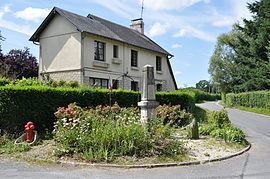Area 9.56 km² | Region Normandy Canton Livarot Population (2010) 307 Local time Thursday 1:09 PM | |
 | ||
Weather 11°C, Wind W at 19 km/h, 61% Humidity | ||
Auquainville is a former commune in the Calvados department in the Normandy region of north-western France. On 1 January 2016, it was merged into the new commune of Livarot-Pays-d'Auge.
Contents
- Map of 14140 Auquainville France
- Geography
- History
- Administration
- Demography
- Civil heritage
- Religious heritage
- Notable people linked to the commune
- References
Map of 14140 Auquainville, France
The inhabitants of the commune are known as Auquainvillais or Auquainvillaises.
Geography
Auquainville is located some 10 km south of Lisieux and 13 km west by north-west of Orbec. Access to the commune is by the D149 road which comes from Saint-Martin-de-Mailloc in the north-east and passes south through the commune and the village continuing to Livarot in the south-west. The D64 road comes from Saint-Martin-de-la-Lieue in the north and passes south through the east of the commune to Fervaques. The D135B branches east off the D64 in the commune and joins the D135 just east of the commune. Apart from the village there are the hamlets of La Blondeliere in the west with Le Mollants and Le Maubuisson in the east. The commune is mixed forest and farmland with a particularly large forest to the west of the village (the Bois des Grandes Ventes).
The Touques river passes through the commune from south to north just east of the village and continues north to join the ocean at Trouville-sur-Mer. The Ruisseau de la Marette rises in the commune and flows east into the Touques.
History
In 1831 Auquainville with 456 inhabitants merged with Saint-Aubin-sur-Aquainville with 91 inhabitants which was in the south of the territory.
Administration
List of Successive Mayors
(Not all data is known)
Demography
In 2010 the commune had 307 inhabitants. The evolution of the number of inhabitants is known from the population censuses conducted in the commune since 1793. From the 21st century, a census of communes with fewer than 10,000 inhabitants is held every five years, unlike larger towns that have a sample survey every year.
Sources : Ldh/EHESS/Cassini until 1962, INSEE database from 1968 (population without double counting and municipal population from 2006)
Civil heritage
The commune has a number of buildings and structures that are registered as historical monuments:
Religious heritage
The commune has several religious buildings and structures that are registered as historical monuments:
